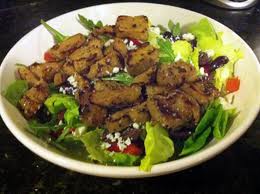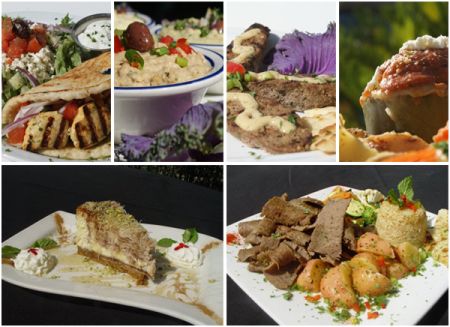
Through the centuries, the Greeks fully exploited to their advantage everything foreign. Slowly-slowly they created and stabilized their own traditional Greek cuisine, bringing it to enviable levels. To this successful evolutionary course of Greek, Cypriot and Island cuisine contributed not only the experiences gained or the skillfulness of the Greek people but also the great variety of feeding stuff produced on this land. Even if some less fortunate people who cannot visit Greece, can have a taste of the Greek cuisine at their respective countries at their favorite Greek neighborhood restaurant. This does describe the popularity of Greek cuisine; but for me, it is not just another weekend dining option for me, but something more. If I had to define what food truly means to me, then it would be “simply Greek!”
It takes a lot of thinking, and still makes it difficult to rank down the various delicacies Greece has to offer. Greek food is simple and elegant, with flavors subtle to robust, textures smooth to crunchy, fresh and timeless, nutritious and healthy. Preparing and enjoying Greek food, anywhere in the world, is an adventurous journey into the cradle of civilization and the land of the Gods of Olympus. Discovering, tasting, experiencing Greek food: truly one of the joys you all can share. Spices, garlic, oregano, basil, mint, and thyme all add to the aura and create a distinguished taste which is no less than an exotic experience on its own. Be it the appetizers or the starters, snacks and the street food, or the classic ancient recipes – all just add to the kitchen’s dignity. All have an elegance of their own.

Ask someone about Greek food, and some version of all or most of the classic ancient dishes will be mentioned. They range from the very simple to the complex, and all bring to mind images of Greece with its hills of olive groves and vineyards, flocks of sheep and goats, beaches, antiquities, and whitewashed homes with red tile roofs – not to mention its churches, arts, music, and wonderful people.
It would be pretty unfair to pick out one, but the traditional Meze arguably stands out. More than appetizers (orektika in Greek), although the dishes are often the same, the meze is an accompaniment to beverages – usually alcoholic – and mezethes (plural) are often combined to make an entire meal. Each meze is served on a small plate (more than one plate for a large group), and the choice of what to serve is limitless. From a small plate of leftovers or sliced tomatoes, cheese, and cucumbers, to prepared dishes, the meze speaks to hospitality.
A little different can be said about Kolatsio. Pronounced “koh-laht-see-YOH”, the word means “snack,” but for many, the Kolatsio is as regular as any meal. Because Greeks generally do not eat a big breakfast, and because mealtimes are often delayed – dinner in mid afternoon, supper in late evening – a Kolatsio in late morning has become routine for many. Here are favorite snack dishes, many of which are also street foods that can be found on almost every corner in Greek cities and towns. In the Greek tradition, desserts are very light so heavy sweets are often eaten as Kolatsio.
Ah! And no words about the Phyllo cheese triangles. I really marvel at how quickly and efficiently one can butter and fold the phyllo (FEE-loh) sheets into neat little triangle packets.There are many different variations, and needless to say, you love them all.
Among the non-vegetarian delights that Greece has produced, the Pastitsio is strikingly delicious and looks just amazing when served. It is basically baked pasta with meat and bechamel topping. Three essential components make up this dish – pasta, meat filling, and a creamy bechamel sauce which are layered in a pan and baked to a golden brown. Each stage will require dirtying some pots and pans, but I’m pretty sure that you will agree that the end result is well worth the clean up!
And then there is the fried cheese appetizer or the Saganaki, the Greek salad or Horiatika Salata, the chicken pea sour or Revithosoupa and many more. Variety, class, taste – all are intact.
If you are visiting Greece, do have a go at Grape must – Moustos. This ancient and now almost forgotten classic recipe is rarely found in restaurants around the world. Moustos is made using the juice squeezed from fresh grapes. In Greece, we make large quantities during the September grape harvest, and it is a great project for kids. It freezes well, and can be used throughout the year. Moustos is used to make petimezi, a grape syrup known since ancient times that is used like maple syrup, Grape Must Pudding (Moustalevria), and various types of sweets.
Ah…well! it certainly gets so difficult for a true Greek food lover to word out his passion for the above, and specially when he has had most of them in the best of the restaurants. My ultimate word of advice would be – just go for it! People trying Greek dishes in their kitchens should begin with the basic recipes – Pasta salad with Greek dressing and yoghurt or the Greek Pita.
From simple to elaborate, the classic dishes that delight Greek food enthusiasts the world over are no less in number and certainly are class apart. For me, Greek food is the best in the world. Not just because they use fresh vegetables and they do not over-power with spices, but because it comes with the whole package of wine and conversation that can go all afternoon or all night long. As anyone who has visited Greece will tell you, eating and drinking is a way of life there.
Are you missing out on one of the best aspects of living in Greece? Come explore the rich culinary traditions of the country as you sample the best of Greek food.


